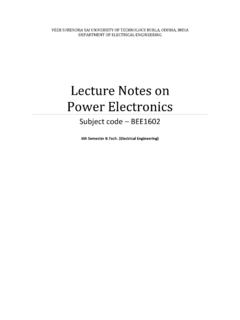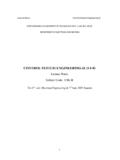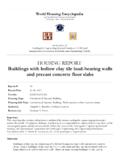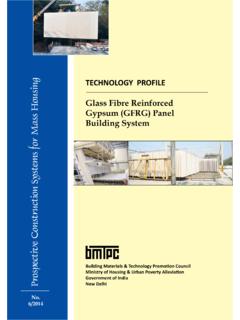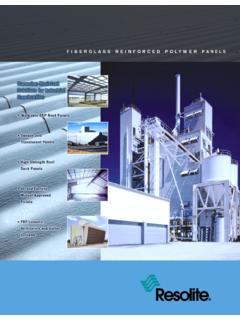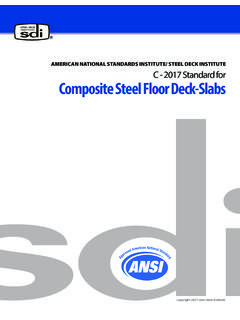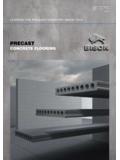Transcription of Department of Civil Engineering
1 Department of Civil Engineering 5TH SEM Lecture Notes on STRUCTURAL DESIGN BCE301 Disclaimer This document does not claim any originality and cannot be used as a substitute for prescribed textbooks. The information presented here is merely a collection by the committee members for their respective teaching assignments. We would like to acknowledge various sources like freely available materials from internet particularly NPTEL course material from which the lecture note was prepared. The ownership of the information lies with the respective authors or institutions. Further, this document is not intended to be used for commercial purpose and the committee members are not accountable for any issues, legal or otherwise, arising out of use of this document. The committee members make no representations or warranties with respect to the accuracy or completeness of the contents of this document and specifically disclaim any implied warranties of merchantability or fitness for a particular purpose.
2 Syllabus Module-I Properties of concrete and reinforcing steel, Philosophy, concept and methods of reinforced concrete design, Introduction to limit state method: Limit state of collapse and limit state of serviceability. Application of Limit state method to rectangular beams for flexure, shear, bond and torsion. Module-II Design of doubly reinforced beams. Design of T-and L-beams. Design of one way and two way slabs, Design of staircases. Module-III Design of short and long columns with axial and eccentric loading, design of isolated column footing. Module-IV Design principle of masonry structures: Brick and stone masonry. Design of masonry short and long walls, columns and retaining walls. Reference Books: 1. Limit state design of reinforced concrete by Verghese, PHI 2. reinforced concrete : Limit state by Jain 3. reinforced concrete by Punmia, Jain and Jain 4. SP-16 and SP-32. MODULE-1 Introduction reinforced concrete , as a composite material, has occupied a special place in the modern construction of different types of structures due to its several advantages.
3 Due to its flexibility in form and superiority in performance, it has replaced, to a large extent, the earlier materials like stone, timber and steel. Further, architect's scope and imaginations have widened to a great extent due to its mouldability and monolithicity. Thus, it has helped the architects and engineers to build several attractive shell forms and other curved structures. However, its role in several straight line structural forms like multistoried frames, bridges, foundations etc. is enormous. concrete concrete is a product obtained artificially by hardening of the mixture of cement, sand, gravel and water in predetermined proportions. Depending on the quality and proportions of the ingredients used in the mix the properties of concrete vary almost as widely as different kinds of stones. concrete has enough strength in compression, but has little strength in tension. Due to this, concrete is weak in bending, shear and torsion.
4 Hence the use of plain concrete is limited applications where great compressive strength and weight are the principal requirements and where tensile stresses are either totally absent or are extremely low. Properties of concrete The important properties of concrete , which govern the design of concrete mix are as follows (i) Weight The unit weights of plain concrete and reinforced concrete made with sand, gravel of crushed natural stone aggregate may be taken as 24 KN/m3 and 25 KN/m3 respectively. (ii) Compressive Strength With given properties of aggregate the compressive strength of concrete depends primarily on age, cement content and the water cement ratio are given Table 2 of IS 456:2000. Characteristic strength are based on the strength at 28 days. The strength at 7 days is about two-thirds of that at 28 days with ordinary portland cement and generally good indicator of strength likely to be obtained. (iii) Increase in strength with age There is normally gain of strength beyond 28 days.
5 The quantum of increase depends upon the grade and type of cement curing and environmental conditions etc. (iv) Tensile strength of concrete The flexure and split tensile strengths of various concrete are given in IS 516:1959 and IS 5816:1970 respectively when the designer wishes to use an estimate of the tensile strength from compressive strength, the following formula can be used Flexural strength, fcr= fck N/mm2 (v) Elastic Deformation The modulus of elasticity is primarily influenced by the elastic properties of the aggregate and to lesser extent on the conditions of curing and age of the concrete , the mix proportions and the type of cement. The modulus of elasticity is normally related to the compressive characteristic strength of concrete Ec=5000 fck N/mm2 Where Ec= the short-term static modulus of elasticity in N/mm2 fck=characteristic cube strength of concrete in N/mm2 (vi) Shrinkage of concrete Shrinkage is the time dependent deformation, generally compressive in nature.
6 The constituents of concrete , size of the member and environmental conditions are the factors on which the total shrinkage of concrete depends. However, the total shrinkage of concrete is most influenced by the total amount of water present in the concrete at the time of mixing for a given humidity and temperature. The cement content, however, influences the total shrinkage of concrete to a lesser extent. The approximate value of the total shrinkage strain for design is taken as in the absence of test data (cl. ). (vii) Creep of concrete : Stress-strain curve of concrete Creep is another time dependent deformation of concrete by which it continues to deform, usually under compressive stress. The creep strains recover partly when the stresses are released. Figure shows the creep recovery in two parts. The elastic recovery is immediate and the creep recovery is slow in nature. Thus, the long term deflection will be added to the short term deflection to get the total deflection of the structure.
7 Accordingly, the long term modulus Ece or the effective modulus of concrete will be needed to include the effect of creep due to permanent loads. The relationship between Ece and Ec is obtained as follows: /cccfE Where, c =short term strain at the age of loading at a stress value of fc =creep co-efficient =crc cr =ultimate creep strain The values of on 7th, 28th and 365th day of loading are , and respectively. Then the total strain=cccrcefE Where, Ece = effective modulus of concrete . From the above Equation, we have 1cccceccrccrfEE The effective modulus of Ece of concrete is used only in the calculation of creep deflection. It is seen that the value of creep coefficient is reducing with the age of concrete at loading. It may also be noted that the ultimate creep strain cr does not include short term strainc . The creep of concrete is influenced by Properties of concrete Water/cement ratio Humidity and temperature of curing Humidity during the period of use Age of concrete at first loading Magnitude of stress and its duration Surface-volume ratio of the member (f) Thermal expansion of concrete The knowledge of thermal expansion of concrete is very important as it is prepared and remains in service at a wide range of temperature in different countries having very hot or cold climates.
8 Moreover, concrete will be having its effect of high temperature during fire. The coefficient of thermal expansion depends on the nature of cement, aggregate, cement content, relative humidity and size of the section. IS 456 stipulates (cl. ) the values of coefficient of thermal expansion for concrete / oC for different types of aggregate. Workability and Durability of concrete Workability and durability of concrete are important properties to be considered. The relevant issues are discussed in the following: The workability of a concrete mix gives a measure of the ease with which fresh concrete can be placed and compacted. The concrete should flow readily into the form and go around and cover the reinforcement, the mix should retain its consistency and the aggregates should not segregate. A mix with high workability is needed where sections are thin and/or reinforcement is complicated and congested. The main factor affecting workability is the water content of the mix.
9 Admixtures will increase workability but may reduce strength. The size of aggregate, its grading and shape, the ratio of coarse to fine aggregate and the aggregate-to-cement ratio also affect workability to some degree. Measurement of workability (a) Slump test The fresh concrete is tamped into a standard cone which is lifted off after filling and the slump is measured. The slump is 25 50 mm for low workability, 50 100 mm for medium workability and 100 175 mm for high workability. Normal reinforced concrete requires fresh concrete of medium workability. The slump test is the usual workability test specified. (b) Compacting factor test The degree of compaction achieved by a standard amount of work is measured. The apparatus consists of two conical hoppers placed over one another and over a cylinder. The upper hopper is filled with fresh concrete which is then dropped into the second hopper and into the cylinder which is struck off flush.
10 The compacting factor is the ratio of the weight of concrete in the cylinder to the weight of an equal volume of fully compacted concrete . The compacting factor for concrete of medium workability is about Durability of concrete A durable concrete performs satisfactorily in the working environment during its anticipated exposure conditions during service. The durable concrete should have low permeability with adequate cement content, sufficient low free water/cement ratio and ensured complete compaction of concrete by adequate curing. For more information, please refer to cl. 8 of IS 456. Design mix and nominal mix concrete In design mix, the proportions of cement, aggregates (sand and gravel), water and mineral admixtures, if any, are actually designed, while in nominal mix, the proportions are nominally adopted. The design mix concrete is preferred to the nominal mix as the former results in the grade of concrete having the specified workability and characteristic strength (vide cl.)



